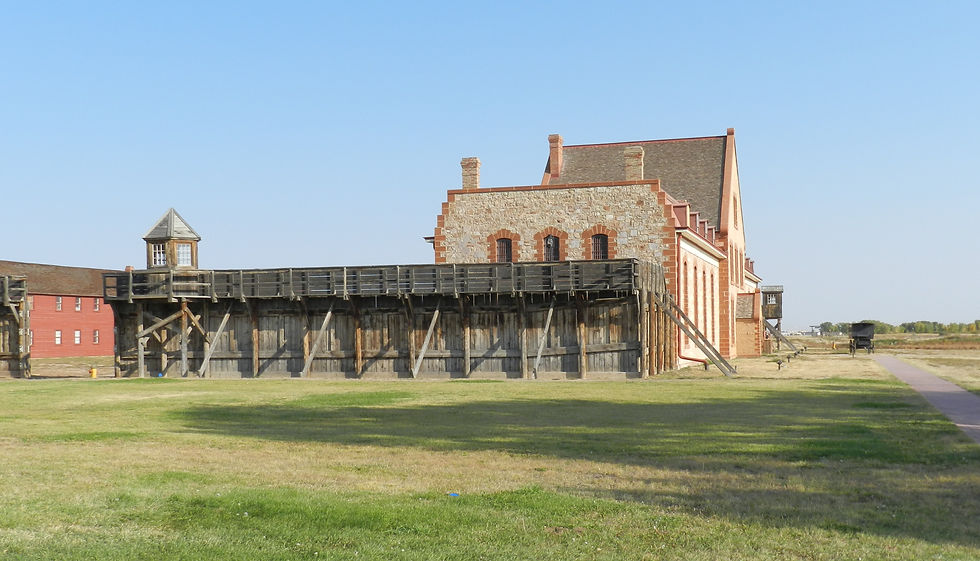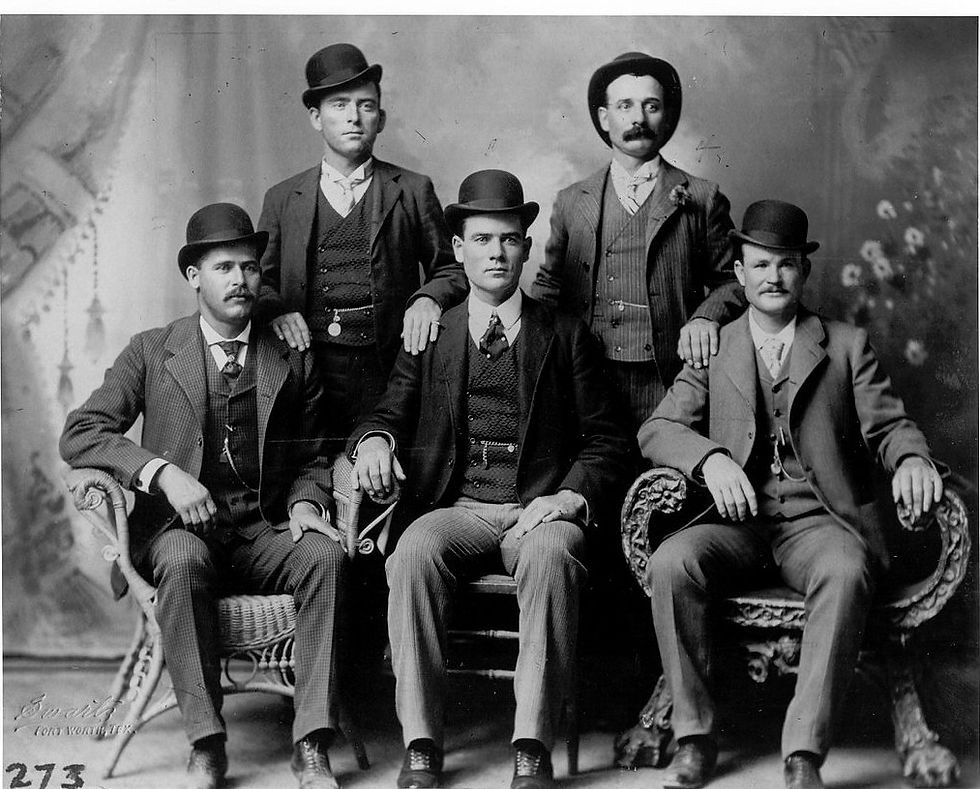Butch Cassidy and the Wyoming Territorial Prison
- Cecil Cherry
- Jul 25
- 7 min read
By: Cecil Cherry

Two days after robbing the payroll from a Bolivian silver mine, two famous bandidos from the United States were having lunch in a small eatery in San Vicente, Bolivia. Their lunch was interrupted by Bolivian calvary and police. It is November 6, 1908, and local law enforcement was tipped off that these same Americanos are the two men responsible for the payroll robbery. The informant recognized the foreigners because they had a mule from the mining company that had been robbed earlier. Shots from the soldiers and law immediately broke the tranquil day and the criminals returned fire. Little did the desperados know, but they were surrounded. They fled and sought cover in an abandoned house. The gun battle raged for the rest of the day and late into the night. Several soldiers were killed or wounded during the initial onslaught.
This was not the first time either of the men had run afoul of the law. They had been in and out of trouble for the latter part of the nineteenth century. The duo was Americans Robert Leroy Parker and Harry Alonzo Longabaugh, known more famously as Butch Cassidy and the Sundance Kid.
One of the first times Parker had less than legal entanglements was in Lander, Wyoming in 1892. He was arrested and convicted for dealing in and selling stolen horses and cattle. He was sentenced to a two-year term in the Wyoming Territorial Prison in Laramie, Wyoming. He would become, in time, one of the most famous inmates ever to serve time in the Territorial Prison.

The Wyoming Territorial Prison was built in 1872 and is one of the oldest buildings in Wyoming. In 1873 the Territorial Prison was opened for business. From 1873 until 1890 it was a Federal Penitentiary, and from 1890 through 1901 it was operated as a State Prison. Shortly after opening, out of the inaugural 44 inmates, 11 escaped. In the first five years of operation, many problems were experienced, including a fire. On top of these issues, by 1877 the prison was filled to overcapacity. In the next 11 years, there were no more than three inmates being housed in the prison due to horrible living conditions. In 1889 a new cell block was built. With this addition, a total of 150 inmates could serve out the remainder of their sentences. A central kitchen was built, along with rooms for guards, a chow hall, and steam heat for the harsh, cold winters. For the most hardened convicts, cells for solitary confinement were constructed. The State of Wyoming did not discriminate because they even added cells for women that ran astray of the law.
The reputation of the prison went from bad to worse over the decades of operation. The prison was overcrowded and understaffed. Wyoming then, as now, is noted for harsh winters. It was difficult to heat the prison. Funding was also insufficient and it was a struggle to pay staff. There was a lack of essential facilities and fundamental conveniences such as hot water, making the sanitary conditions less than desirable. Discipline was handed out with an iron fist, including use of a pole to tie prisoners up for whipping, solitary confinement, and even executions were not unheard of.
Longabaugh had a similar start in his criminal career to Parker. He was arrested and convicted for stealing a horse, saddle, and a gun in 1887. He was only 20 years old when he was sentenced to a two-year term in the Crook County Jail in Sundance, Wyoming. Longabaugh’s term was commuted and he was pardoned after completing 18 months of active time. There was hope that he learned his lesson and would go straight and find honest work. Unfortunately, that was not to be for either Longabaugh or Parker.
Sometime in the 1890s, Parker and Longabaugh met up on one of the many networks of paths and routes in Wyoming known as the Outlaw Trail. The Wild Bunch’s hideout, The Hole in the Wall, was located along one of these passages. Both men were robbing banks and working as ranch hands during this time. Around 1896 Longabaugh joined Parker’s Wild Bunch. It was with this gang that they began robbing trains and banks together.
In 1899 the Wild Bunch with Parker and Longabaugh pulled off one of their more notorious train robberies. The Wild Bunch stopped a Union Pacific train on June 8, 1899 near Wilcox, Wyoming in Albany County. They made their way to the express car where they placed dynamite and/or black powder strategically to blow the safe open. Enough explosives were used that day that they nearly blew the express car to pieces. The outlaws were able to abscond with a large sum of cash and jewelry.

On August 29, 1900, history repeated itself when the criminal crew attacked another Union Pacific train, this time in Tipton, Wyoming. Just like the Union Pacific Train robbery, they used explosives to blast open the safe and steal the money totaling approximately three million dollars in 2025 currency. As a result of this robbery, the gang’s reputation as audacious and successful outlaws grew throughout the American West.
The equally famous law enforcement agency known as The Pinkerton Detective Agency was hired to bring Parker, Longabaugh, and the other members of the Wild Bunch to bay and be held accountable for their crimes. Wanted posters featuring the likeness of the bad guys were popping up across every cow and mining town across the plains and the noose was getting ever tighter.
Parker and Longabaugh, now accompanied by Longabaugh’s lady friend, Etta Place, fled east to New York City. They stayed in the city for about two weeks. The trio hopped a British ship on February 20, 1901. By March of the same year, they disembarked in Buenos Aires, Argentina. The robbers attempted to go straight and bought a huge ranch. For approximately five years they raised cattle, horses, and sheep.
Parker and Longabaugh could not resist the siren’s call of their life of thieving. They left their ranch and presumably sold the livestock and returned to a life of crime. They began robbing trains, banks, and mining operations throughout South America, from Argentina to Bolivia, and areas in between. During this time the Pinkerton Detective Agency was still hot on the trail of the bad guys. There was a $10,000 reward for the capture of Parker and Longabaugh. The bandits slipped through the hands of the detectives and continued their series of crimes just like they did in the United States.
One must assume that Parker and Longabaugh considered the long sentences awaiting them if they were captured and extradited back to America. Their original sentences of two years would certainly pale in comparison to what awaited them if they were captured. It had to occur to the criminal duo that the law of averages would catch up to them and their luck eluding law enforcement in two countries would run out.
On August 21, 1905, Longabaugh was involved in a shootout along the Chilean coast in the town of Antofagasta. Longabaugh killed a police officer in the gun battle and was captured. He was soon released on bail with the help of American Embassy. It is believed the diplomat may have had ties to Colorado and was trying give Longabaugh a helping hand and a head start to get away from local law enforcement and certain incarceration. Once Longabaugh got out of jail, he jumped bail to make his way back to Parker. Time was certainly not on the side of Parker and Longabaugh. Law enforcement from two continents were hot on their trail. Capture or death was certain. By 1906, Longabaugh’s longtime girlfriend, Place, grew tired of a life on the run and returned to the United States.
With Longabaugh skipping bail, he and Parker reunited, resuming their life of crime. For the next two years they robbed banks, trains, and silver mine payrolls. They were drawing more and more attention with their illicit activities. The Pinkertons as well as the South American authorities were now hot on their trail. Sooner or later, their luck would run out.
EPILOGUE November 6, 1908: For the rest of the night all was quiet in the house Parker and Longabaugh fled to for cover from the gun battle in San Vincente, Bolivia. On November 7, 1908, as night gave way to dawn, local law enforcement and the Bolivian soldiers that had earlier exchanged gunfire with the infamous Bandidos Yanquis (a nom de guerre given to Parker and Longabaugh by South Americans), approached the house. Not knowing what to expect, they found the payroll robbers dead. Longabaugh had a fatal gunshot wound to the forehead and Parker was dead from a self-inflicted gunshot to his temple. It seemed as though the bad guys ran low on ammunition and realized they were trapped and there was no avenue for escape. They chose death over capture and spending the rest of their lives in a South American prison or being sent back to the United States to answer for their crimes.
The two would most certainly have received life sentences if not the death penalty in either South America or the United States. Their decision to commit a murder suicide was the way they escaped the horrid conditions of the penitentiary in Wyoming or Bolivia.
Parker and Longabaugh’s reputations live on in history and in cinema. In 1969, 61 years after the shootout in Bolivia, Paul Newman and Robert Redford portrayed the desperados in the highly fictionalized Hollywood production, “Butch Cassidy and the Sundance Kid.” Being immortalized on the silver screen cemented them to the annals of history as two of the most infamous 19th Century outlaws. Even today, their cabin, The Hole in the Wall, can still be seen in the Old Trail Town in Cody, Wyoming. For the more adventurous minded, Parker and Longabaugh’s ranch can be visited in Patagonia near Cholila, Argentina. Some of the original buildings have been refurbished, allowing visitors to imagine the daily life of the outlaws as it was in 1901.
In December 1901 the new Wyoming Frontier Prison was opened in Rawlins, Wyoming, and the Wyoming Territorial Prison was closed. The Territorial Prison was handed over to the University of Wyoming (UW), who turned the former penitentiary into an Agricultural Experiment Station for the next 86 years. Since UW was a land grant university, the grounds of the prison became a research center for agriculture. The focus of the study was livestock, crops, safe edible food, sustainable agriculture, and plant and animal health. In 1989 the grounds were closed again. 1991 saw the prison re-open, but this time it was opened to the public as a museum. The Wyoming Territorial Prison was registered as a State Historical Site in 2004 and is still open to this day for tours.
About the Author
Cecil Cherry—Cecil Cherry is a native North Carolinian who graduated from East Carolina
University and retired as a law enforcement officer from the North Carolina State Bureau of
Investigation. Cecil enjoys outdoor pursuits, travelling to North Carolina wineries with his wife,
Pam, and sharing the bounty of field to plate with friends and family.

.png)



















